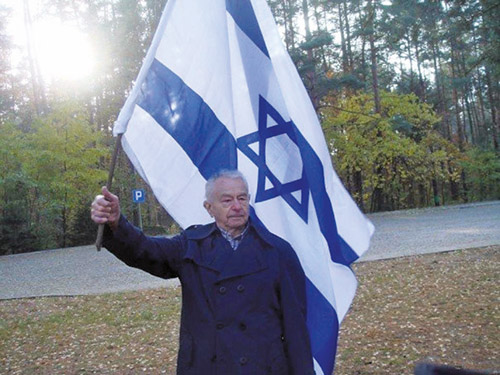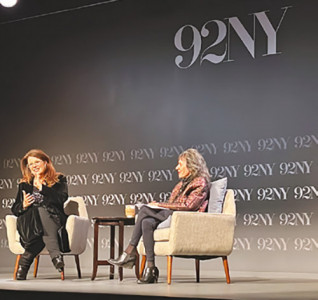
With the number of Holocaust survivors dwindling rapidly, the all-important documentary “Four Winters: A Story of Jewish Partisan Resistance and Bravery in WW2” is now screening at select locations across the country, and soon will travel the globe. The riveting 90-minute film, which took 10-plus years to come to fruition, is a must-see.
The first-person stories of brave Jewish partisans give voice to the over 25,000 men and women who fought back against the Nazi slaughterers, shattering the myth of Jewish passivity. With the glow of wolves’ eyes staring at them in the forests, they took refuge and gathered equipment to fight and film the unfathomable existence they endured for four winters in Eastern Europe. One survivor scoffed, “Better than the Nazis being there,” adding with a laugh, “The wolves kept the Nazis away.”
Interspersed with authentic film clips and photographs gathered from archives around the world, and personal records, the scenes show the horrors the partisans faced in the Shoah and the glory of their victories. Many orphaned teens took to the forests and gathered ammunition while forging ahead with whatever it took to avenge the deaths of their families.

Writer/director Julia Mintz was on hand after the film was shown at the 92nd Street Y on April 17, Yom HaShoah 2023, as part of its tour. A 90-minute interview conducted by moderator Annette Insdorf offered the audience a look into the creation of the film.
Mintz, who took on the project not knowing anything about the Jewish partisans, remarked, almost in disbelief, that she now goes on the subway and talks about the Holocaust. She revealed that all the partisans she interviewed thought they would not make it out alive. Many were killed, she said sadly, but the brave heroes in “Four Winters” were the lucky ones who survived until liberation.
The director spoke of spending countless days interviewing over 30 partisans in their homes, uncovering the experiences they endured during four winters in the cold, snowy forests. She made sure to include women telling their stories, which were as harrowing as those of the men. There were reports of unmedicated surgeries, beatings and shootings. One of the women was a teenage photographer who managed to escape with her camera. With a blanket over her head, she developed the film and hid the pictures in the forest.
Mintz made the editorial decision to reduce the number of Jewish partisans highlighted in the film, none of whom knew the others before, so that the stories would better blend. Intent on a firsthand oral history, Mintz emphasized that no scholars were used in the film. After more than three quarters of a century had passed since the war ended, a limited pool of male and female Jewish resistance fighters gave their personal accounts with clear footage of never-before-told stories. From escaping from moving trains to blowing up locomotives and killing Nazi enemies, the dramatic scenes were tempered with some levity by the participants.
The partisans shown in the film lived to advanced ages, but there was a void in not knowing about their lives after the war. A private interview with Susan Fleishmann Farbstein, a daughter-in-law of survivor Isadore Farbstein, was revealing. After the war, Isadore (March 5, 1920-March 18, 2013), known as Izzy or Ignatz to his family and friends, from Parczyv, Poland, married Regina Gewercer Farbstein (May 3, 1919-March 7. 2017). Regina was also a partisan. He, a house goods jobber, and she, a homemaker, together had three children. Their eldest son Maurice was born in Berlin before they immigrated to Waterloo, Iowa in 1950. Their second son, Samuel, a doctor, was born in Chicago and married Susan from Linden, New Jersey; they relocated to the Chicago suburbs, where they raised their two children. Regina and Isadore’s daughter, Gloria, their youngest child, was also born in Chicago. Gloria, married to Rabbi David Clyman, lives in Clifton.
From three children, the Farbsteins were blessed with nine grandchildren. To date, they have a lasting legacy with 12 great-grandchildren. Susan and Sam’s young grandson Isaac (Izzy) is named after Isadore.
Isadore Farbstein mentioned in the film that he stood 5 feet, 4 inches. In his daughter-in-law Susan’s words, “He was the bravest man in the world.”
In 2007, Farbstein with his children and grandchildren visited Treblinka, where his and his wife’s family, along with the residents of the entire town of Parczyv, were killed within 24 hours of their arrival at the camp during the war.
“We had a funeral for our family that day at Treblinka,” Susan added. “It gave [my father-in-law] closure” and “dignified our family.”
“We also visited the family who lived next door to Dad when he was growing up. During the war, they hid Dad and his brother underneath their house in a hole. For years I had heard the stories, but then I bore witness to this haven. And I met the lone family survivor, a then 9-year-old at wartime, who could have blabbed at any time putting everyone at risk. What an awesome secret he kept, now an old man.”
Those brave souls who lived in the forests of Eastern Europe over four winters once again showed their courage by telling their stories. At the end of the film, Gertie (Gertrude Boyarski) asks: “Why me?” She said she thinks about that and guesses she lived “to tell the story.”
The producers of the film implore, “[Now] the story is ours to tell the world—and tell it we must.”
For more information on upcoming screenings, visit www.fourwintersfilm.com/screenings.
To contribute, tax-deductible donations can be made at www.FOURWINTERSFILM.COM/DONATE.
By Sharon Mark Cohen









